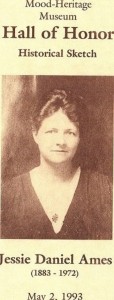 Noted women’s suffragist and social reformer Jessie Daniel Ames had important ties to Williamson County. Born Jessie Harriet Daniel on November 2, 1883, in Palestine, Anderson County, Texas, she was the third of four children in the family of railroad employee James Malcolm Daniel and his wife, Laura Maria (Leonard). In 1893, following a brief residence in Overton, Texas, the Daniel family relocated to Georgetown, where Jessie completed her high school education and entered Southwestern University in 1897. In 1904, two years after her graduation, her father accepted a railroad company position in Laredo and she joined her family there.
Noted women’s suffragist and social reformer Jessie Daniel Ames had important ties to Williamson County. Born Jessie Harriet Daniel on November 2, 1883, in Palestine, Anderson County, Texas, she was the third of four children in the family of railroad employee James Malcolm Daniel and his wife, Laura Maria (Leonard). In 1893, following a brief residence in Overton, Texas, the Daniel family relocated to Georgetown, where Jessie completed her high school education and entered Southwestern University in 1897. In 1904, two years after her graduation, her father accepted a railroad company position in Laredo and she joined her family there.
In Laredo, Jessie met a young army surgeon, Dr. Roger Post Ames, whom she married in 1905. A veteran of the Spanish-American War, Dr. Ames participated in important medical experiments to isolate the causes of yellow fever and malaria. Following his death in 1914, Jessie Daniel Ames, then expecting her third child, returned to Williamson County and joined her widowed mother in operating the Georgetown Telephone Company. Together, the two ladies built the operation into a successful enterprise serving a growing city and county.
An active member of several civic groups, including the Georgetown Woman’s Club, Mrs. Ames became a champion for women’s rights. She organized the Georgetown Equal Suffrage League and directed an eleventh-hour Williamson County voter drive that registered over 3,000 first time women voters, in just seventeen days, for the 1918 election. Building on her success as an activist, she accepted leadership roles in several statewide organizations, including the Texas League of Women Voters, the Texas committee on Prisons and Prison Reform, and the state affiliate of the American Association of University Women. She also served as a delegate-at-large to the Democratic National Conventions in 1920 and 1924.
At a Dallas meeting of women social reformers in 1922, Jessie Daniel Ames learned of important programs conducted by the Commission on Interracial Cooperation. Her later efforts as an employee of the commission led her to form the affiliated Association of Southern Women for the Prevention of Lynching (ASWPL) in 1930. As she noted, “The men were out making studies and surveys of lynchings…and so the women had to get busy and do what they could to stop the lynchings.” Her organization used both education and direct action in programs to eradicate racially-motivated killings. It specifically targeted individuals who claimed to promote lynchings as legitimate means for defending chivalry and womanhood.
Despite fierce opposition and threats of personal violence, Mrs. Ames persevered. She continued to work with the ASWPL and its successor, the Southern Regional Council, until the time of World War II.
She retired from the Commission on Interracial Cooperation in 1944 and moved to a Tryon, North Carolina cottage she called Wren’s Nest. From there she participated in Methodist Church activities, black voter registration drives, and a women’s study group on world politics. Later, in frail health, she returned to Texas, to live with a daughter, Lulu Daniel Ames. She died in Austin on February 17, 1972, and was buried in the IOOF Cemetery in Georgetown, the city where she began her life as an active leader of progressive social reform.
For additional research/information the following links may be helpful:
Texas State Historical Association
Williamson County Historical Commission
University of Mississippi, Center for the Study of Southern Culture
